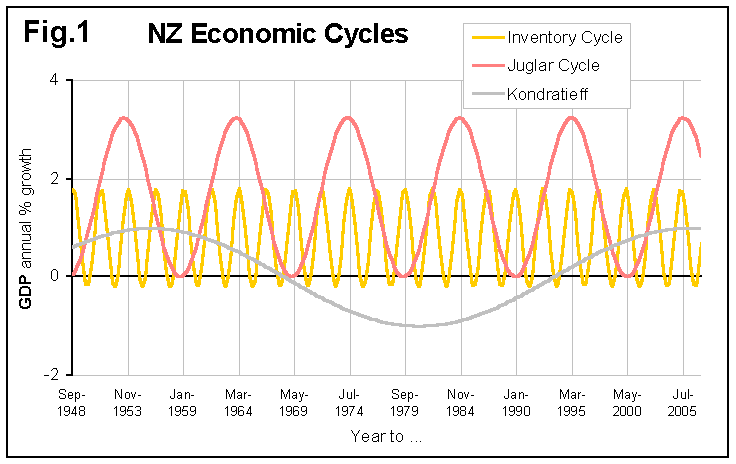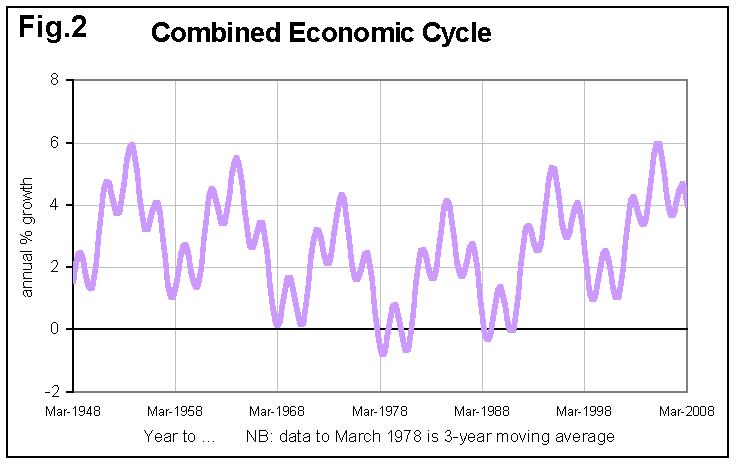
Keith Rankin, 31 December 1998
1998 is over. Just before Christmas, the latest gross domestic product (GDP) data (for the year to September 1998) was released. The Prime Minister is happy; the doomsayers seem to be wrong; the 1998 recession is officially over.
On 1 July my Recession and Depression in Context was published in the NZ Herald as "What Depression; we've been in worse shape often enough". In that article, I suggested that the negative growth figures were essentially a cyclical blip, and that forces for a return to economic growth were already present.
Here I will comment on the cyclical nature of the post-WW2 New Zealand economy, how the background cyclical pattern makes growth forecasting a less difficult art than is usually supposed, and how the "performance" of the economy in any group of years can be judged against a "counterfactual" of overlaying sine waves.
Joseph Schumpeter, in his 1939 tome Business Cycles, emphasised the role of three difference economic cycles (rhythms?) as being essentially regular, as being important constituents of the growth process (a dynamic process). For Schumpeter, economic cycles are not irregular fluctuations in business activity caused by random events (or "shocks" as economists like to call "exogenous" events). Schumpetarian and neo-Schumpetarian growth theories are called "endogenous" growth theories or models. (See my The "Growth Illusion" vs. "New Growth Theory".)
Schumpeter based his growth theory around three cycles: (i) a short-duration trade or inventory cycle (called, after its discoverer, the Kitchen cycle) of no more than 4 years duration; (ii) an industrial capital formation cycle of just over 10 years (the Juglar cycle); and (iii) a cycle of approximately 50 years duration (2 generations) named the Kondratieff cycle.
I have fitted these three cycles to New Zealand's quarterly GDP for the years 1978 to 1998, and extrapolated the cycles to cover the 60 years from 1948 to 2008 (Figure 1). The cycles are combined as a single hypothetical growth series in Figure 2. They have frequencies of 2.57 years (Kitchen), 10.4 years (Juglar), and (by assumption) 50 years for the Kondratieff cycle.


If we take on Schumpeter's perspective, in the absence of exogenous influences (the most important of which is policy driven proactively by ideology and not reactively by circumstance), growth in the New Zealand economy would have peaked in line with the Juglar cycles in 1953, 1963/64, 1973/74, 1984, 1994/95 and will peak again in 2004/05. We can expect a particularly strong period of growth in the middle of the next decade (ie in the mid-2000s) when three cyclical peaks converge.
In Figures 3 and 4, I have added actual GDP growth data to the overlay series of Figure 2. In Figure 3 for 1949-1978, the data plotted is 3-year moving average annual data, which is not sensitive enough to show the short period cycles. Data post-1978 in both charts is quarterly, with growth rates 4-quarter GDP averages for the year ending June 1998 (or whatever) relative to the previous whole year.


We find that the economic growth rates so far for the late 1990s were entirely predictable from this approach. In the absence of any policy stuff-ups (such as I presume happened in 1951/52, and as did happen in 1976 and 1991) or masterstrokes (such as appears to have happened around 1958), I predict that there will be a short-lived recovery in 1999, another bout of recession in 2000/01, and sustained growth in GDP and employment by 2003.
Points to note from the historical record are that the 1953 growth peak failed, that Muldoon got it right more often than he got it wrong (while battling all that a Kondratieff downturn could throw at him), that the New Zealand economy was particularly volatile during the years of world recession in the early 1980s, and that the delay in the recovery in GDP in 1992 (thanks presumably to the recessionary impact of the benefit cuts) created an artificially high growth rate in 1993/94.
For an economic historian such as myself, one of the most intriguing questions is to explain the paucity of growth in the early 1950s. Indeed the decade from 1943 to 1953 was one of the poorest for growth in our history (only really matched by 1984-94). Very little specialist work has been done on the macroeconomy of the 1940s and early 1950s; rather the period has tended to have been used as a benchmark to assess growth in later decades.
1943-53 followed a decade of record economic growth that included the recovery from the Great Depression and a stimulus arising from the start of World War 2. Hence GDP was at historically high levels during the 1940s' growth plateau. The 1940s was a period in which the Labour Government became conservative, and when the conservative union leader Fintan Patrick Walsh dominated the labour movement. The early 1950s was the time of McCarthyism and other Cold War tensions (including the Korean War), when Prime Minister Sid Holland called an early election to break the 1951 waterfront strike, when balance of payments complacency set in following the record wool prices of 1950 and 1951 (due to the Korean War), and when initial steps were taken to liberalise an economy subjected to extensive import and exchange controls in December 1938. It appears that there was a major credit squeeze following an import binge in 1952. One result was a very high poll (11%) in the 1954 election for the Social Credit League, which had separated from its alliance with the Labour Party.
It should also be noted that unemployment in 1952-54 was much higher than the official records show. There was no census in those years, but my intercensal estimates [see my "The New Zealand Workforce: 1950-2000", New Zealand Journal of Industrial Relations, 18(2):214-235; (1993)] reveal that full employment in the early 1950s was something of a myth.
We don't think of the late 1940s and early 1950s as a period of economic failure. This is mainly because the cyclical environment was generally favourable, and failure was therefore less noticeable than it was in the late 1970s or the early 1990s.
The same sort of thing might happen in the early 2000s. A problematic set of policies (including policies well-entrenched such as the 1989 Reserve Bank Act, the 1994 Fiscal Responsibility Act, and the 1990s' health and tertiary education botch-ups) may appear to be not as bad as they really are, because other forces will be generating economic growth that offsets the effects of such policies. On the other hand, if the good policies are adopted, the growth rate may seem too good to be true, possibly leading the Governor of the Reserve bank to misread the situation as Dr Donald Brash did in 1994, thereby creating a credit squeeze different in form but similar in substance to that of 1952/53. By 2008, we might well be in recession once again.
© 1998